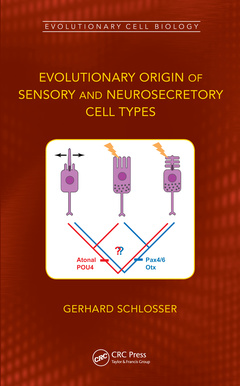Description
Evolutionary Origin of Sensory and Neurosecretory Cell Types
Vertebrate Cranial Placodes, volume 2
Evolutionary Cell Biology Series
Author: Schlosser Gerhard
Language: English
Subject for Evolutionary Origin of Sensory and Neurosecretory Cell Types:
Keywords
Non-neural Ectoderm; TRPC Channel; Atrial Siphon; Sensory Cells; NSC; CNG Channel; Single Cell RNA Seq; Hair Cells; Mechanosensory Cells; Sensory Neurons; SNs; Chordate Ancestor; Olfactory Receptor Neurons; Chemosensory Cells; Chordotonal Organs; Trp Channel; Pharyngeal Slits; Np; Extraocular Photoreceptors; Ribbon Synapse; Corpora Cardiaca; Larval CNS; Phototransduction Cascade; Enteroendocrine Cells; Anteroposterior Axis
Publication date: 06-2023
· 15.6x23.4 cm · Paperback
Publication date: 06-2021
· 15.6x23.4 cm · Hardback
Description
/li>Contents
/li>Readership
/li>Biography
/li>
Preface
Chapter 1 The evolutionary origin of vertebrates
Chapter 2 Teaching old cells new tricks
Chapter 3 Evolution of mechano- and chemosensory cell types
Chapter 4 Evolution of photosensory cell types
Chapter 5 Evolution of neurosecretory cell types
Chapter 6 Evolutionary origin of vertebrate cranial placodes
These books may interest you

Vertebrate Cranial Placodes 264.06 €

Neural Crest and Placodes 166.19 €


